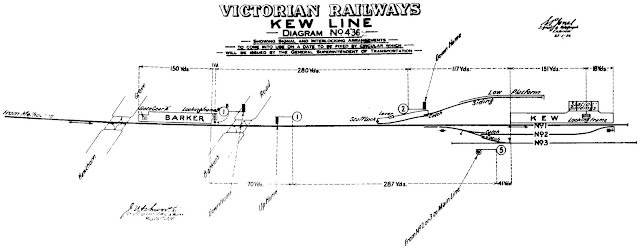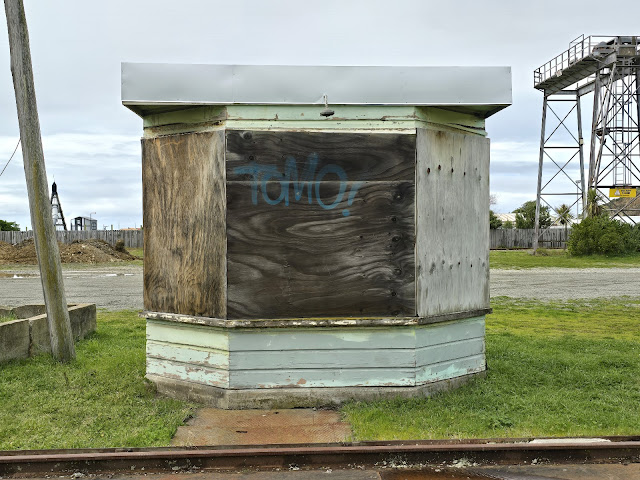 DFB 7335 ready to depart The Strand with the southbound 9:45 Te Huia service to Hamilton. 4 April 2025.
DFB 7335 ready to depart The Strand with the southbound 9:45 Te Huia service to Hamilton. 4 April 2025.
In early March, we spent a long weekend in Auckland, New Zealand’s largest city. While it boasts a fast-growing suburban rail network and the highly anticipated City Rail Link - set to open in 2026 - we had a very specific goal: to ride the Te Huia train from Auckland to Hamilton, a trip long on my railfanning bucket list.
Departing from The Strand on a Rainy Friday Morning
 The 9:45am Auckland to Hamilton Te Huia Service waits for departure time at The Strand Railway Station. An Auckland Transport AM Class Electric Multiple Unit rests in the storage yard. 4 April 2025.
The 9:45am Auckland to Hamilton Te Huia Service waits for departure time at The Strand Railway Station. An Auckland Transport AM Class Electric Multiple Unit rests in the storage yard. 4 April 2025. The weather was classic Auckland: heavy rain as we walked down Queen Street for breakfast. From there, we grabbed an Uber to The Strand Railway Station, the current terminus for Te Huia and the Northern Explorer.
We boarded quickly to escape the downpour, but not before I braved the rain for a snapshot of the train.
Te Huia Train: Connecting Auckland and Hamilton by Rail
Te Huia offers a good alternative to the traffic-heavy drive between Hamilton and Auckland, running six days a week with stops at Rotokauri, Huntly, Pukekohe, and Puhinui. It’s a long-distance commuter train that provides a comfortable way to avoid the traffic.
An information board about the native Huia bird, sadly extinct, in the cafe car. 4 April 2025.
Before departure, I made my way to the café car to purchase our Bee Cards—used across several New Zealand transport networks but not on Auckland network, which uses HOP cards. For around $90, we had return travel covered. The café was well-stocked with hot and cold snacks, quality barista coffee, and even Te Huia merchandise. I bought a cup and playing cards to help with the trip.

Rolling Stock: Nostalgia with a Modern Twist
The Te Huia consists of refurbished British Rail Mark 2 carriages. They were originally built in the UK in the 1970s and imported to New Zealand in the 1990s. These once served Auckland's commuter network as SA and SD cars before being overhauled for Te Huia and reclassified as:
- SR (Scenic Regional) – passenger seating
- SRC (Scenic Regional Catering) – café car
- SRV (Scenic Regional Vehicle) – cab-equipped cars with onboard generators
SR 3285 just after arriving at Frankton Station. 4 April 2025.
SR 3285 waits at Frankton for its next service to Auckland. 4 April 2025.
Te Huia SRV 5893 ready to depart Frankton. 4 April 2025.
Inside, the carriages now feature Wi-Fi and upgraded seating and tables better suited to the approximately 2.5-hour journey. Hauling us along was a DFB diesel-electric locomotive, a dependable workhorse on many of New Zealand’s regional passenger rail routes.
New seating and table arrangement in an Te Huia SR carriage. 4 April 2025.
Internal layout of a Te Huia SR carriage. 4 April 2025.
Door layout on a Te Huia SR carriage. 4 April 2025.
Auckland to Hamilton by Train: The Journey South
We pulled out of The Strand at 9:45 a.m. sharp, cruising through the eastern suburbs along the North Island Main Trunk Line. The ride was smooth, and I noticed major upgrades across Auckland’s rail corridor since my last visit.
Passing Westfield, I saw the pedestrian bridge that once spanned the yard was gone which was a bittersweet moment, as I recalled the many hours spent on the bridge spotting DH working the yard, DX, DFT, and DC locomotives arriving and departing with freight trains, DBR locomotives on the port shunts and DC's and DMU's working MAXX suburban trains on the main line.
Further south, I spotted the new (to me anyway) EMU depot and work on the third main line, both examples of the large investment in the network over the last decade.
Before long, we arrived at Pukekohe, the new southern terminus of Auckland’s electrified rail network. Although Te Huia isn’t electric, the surrounding infrastructure is rapidly modernising with a new station and track layout at Pukekohe and new stations being constructed between here and Papakura.
After descending the Tuakau bank and passing through Pokeno, we sped alongside State Highway 1, sipping coffee and playing cards while watching the countryside slip by. After brief stops at Huntly and the impressive new Rotokauri Station (near The Base Shopping Centre), we passed Te Rapa Yard and arrived on time at Frankton Station just after noon.
DFB 7335 and the 9:45am southbound Te Huia service after arriving at Frankton. 4 April 2025.
Exploring Hamilton and a Minor Delay
With a few hours before our return, we Ubered into Hamilton city for lunch and some shopping. Our driver was amused we’d come to Hamilton just for a day trip.
Back at the station, I took more photos while my partner chatted with one of the train crew. Just as we were ready to depart, a minor mechanical issue—a faulty solenoid switch on a bogie—held us up. The train staff were outstanding, updating us via intercom and personally checking on passengers throughout the delay.
The northbound Te Huia service waits at Frankton station for its 2:05pm departure. 4 April 2025.A Smooth Return
After a 45-minute wait, a maintainer from Te Rapa had fixed the problem, and we were off. The Locomotive Engineer was determined to make up for lost time. Despite hitting a few signal checks as we followed and EMU back into Auckland, we were soon back at The Strand— about 30 minutes behind schedule.
Te Huia at the Strand Station after arriving with a northbound service. 4 April 2025.
DFB 7335 readies for its 5:45pm departure to Hamilton with the evening southbound Te Huia service. 4 April 2025.
Final Thoughts: A Must-Do for Railfans
Our Te Huia train journey from Auckland to Hamilton was an absolute highlight. The refurbished carriages rode well, the staff were friendly and communicative, and the coffee was genuinely excellent. Mechanical hiccups happen, but they were handled professionally.
It was a shame the waiting room wasn't open at Frankton. Passengers had to wait under the platform awning for the train crew to open up the train. A dry and warm waiting room would have been a great asset on the wet and bleak day we traveled.
For rail enthusiasts and casual travelers alike, Te Huia is a scenic, relaxed, and rewarding way to travel between two of New Zealand’s key city centres.
🚆 Know Before You Go: Tips for Riding Te Huia
Timetable & Booking
Te Huia operates Monday to Saturday between Hamilton (Frankton) and Auckland (The Strand), with intermediate stops at Rotokauri, Huntly, Pukekohe, and Puhinui. Check Te Huia’s official website for the most up-to-date timetable and service notices.
Bee Card Required
Te Huia doesn’t accept Auckland’s HOP card—passengers need a Bee Card, which can be purchased onboard at the café car or online. Load it with enough credit for a return journey (about $90 for two adults at the time of writing).
Onboard Amenities
There’s a café car onboard offering barista coffee, light snacks, and Te Huia merchandise. Seating includes tables and generous legroom - a nice touch for a longer-haul regional service.
Departure from The Strand
The Strand Station is located near the bottom of Parnell Rise - accessible via Uber, bus, or a 10–15 minute walk from Britomart. Signage is minimal, so plan to arrive a little early if it’s your first visit.
Railfan Highlights
The refurbished British Rail Mark 2 carriages are a treat for enthusiasts, especially in SRV or SRC configuration. Expect to see DFT diesel-electric locomotives in action, and keep an eye out for infrastructure upgrades along the route like the third main, electrification around Pukekohe, and the EMU depot.
Service Interruptions
While generally reliable, occasional mechanical delays can happen - as I experienced with a solenoid issue on our return trip. Staff were excellent about communication, so just bring a bit of patience and enjoy the journey.
And that's about it.






















































